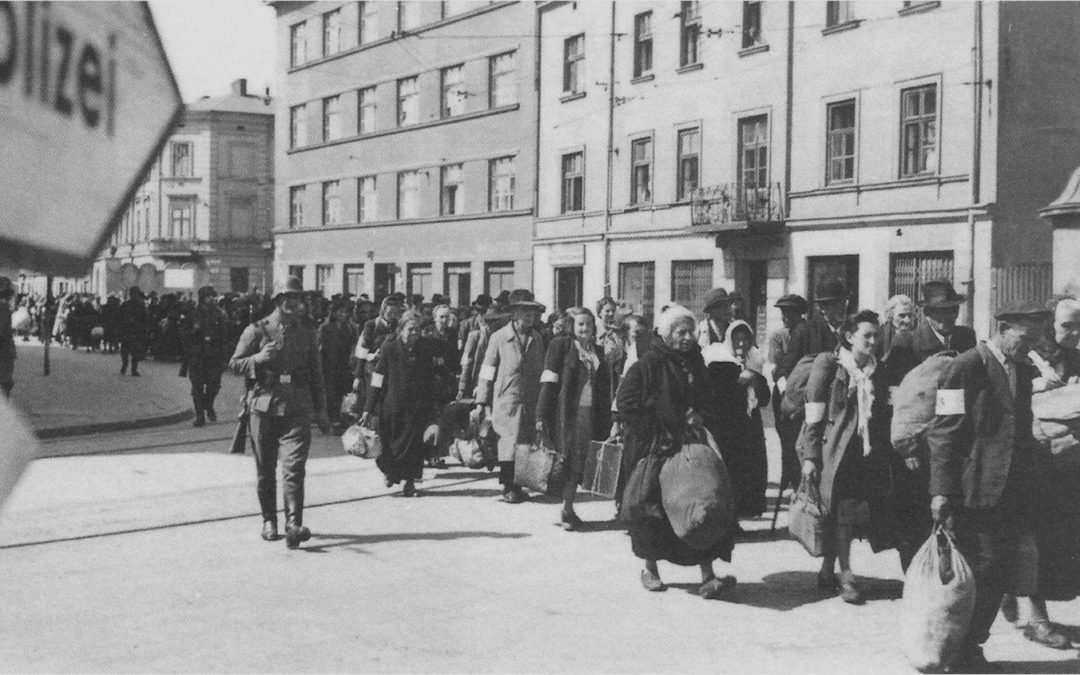By Stanley Bill
In 2018, the Polish government’s politics of memory have been a public relations disaster for the country. A declared intention to defend the good name of “the nation” against false accusations of collaboration in the Holocaust has instead created a wave of international outrage and negative media coverage of Poland’s past and present. From the misconceived formulation of the so-called “Holocaust law” to clumsy public statements from Prime Minister Mateusz Morawiecki, Poland’s leaders have drawn international attention to the vexed question of Polish complicity with German crimes instead of clarifying a complex and painful history in which Polish Jews and non-Jewish Poles suffered on an enormous scale.
It is true that Western understandings of Poland’s history under the German occupation are often inaccurate, but the government has only exacerbated the problem through a mixture of tone-deaf incompetence and cynical manipulation of domestic emotions. In belated response to the public relations fiasco, the Polish parliament ratified a hasty “correction” to the law this week, but the damage to Poland’s reputation had already been done. Despite this uncongenial climate, serious historical research in Poland on the Holocaust has continued to set the highest standards.
A new study published in two hefty and well-documented volumes has shed light on “the fate of Jews in selected counties of occupied Poland,” while also igniting fresh controversy over Polish collaboration with German crimes. Edited by leading Holocaust scholars Barbara Engelking and Jan Grabowski, the study brings together the work of nine different researchers, concentrating on the experience of Jews who went into hiding in small towns and villages after the liquidation of the ghettos by German forces in 1942-1945. Over more than 1600 pages, their work takes an extraordinarily detailed look at nine separate counties (powiaty), using a range of documentary sources from archives in Poland, Germany, Israel and the US to sketch out “micro-histories” of these districts from before the war through the Soviet and German occupations into the postwar period.
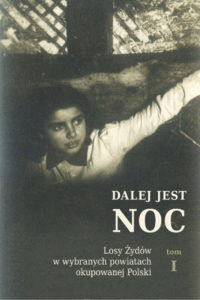
Barbara Engelking and Jan Grabowski (eds.), Dalej jest noc: Losy Żydów w wybranych powiatach okupowanej Polski (Warszawa: Centrum Badań nad Zagładą Żydów, 2018).
The separate pieces of this terrifying mosaic come together to form a heterogeneous, though coherent image. The study shows the many varieties of cruelty implemented by the German occupying forces, the strategies of survival employed by Jews who escaped the ghettos and transportations, the aid of the Polish “righteous,” and the many forms of suffering and death. Most controversially, it presents clear evidence of collaboration of individual Poles in the Holocaust on a scale that has not previously been documented in such detail. In this article, I will summarise and evaluate the key findings, while also interrogating some of the authors’ broader claims, especially on the point of numbers.
More generally, it is important to underline that the vast majority of responsibility for the Holocaust lies with Nazi Germany. The new study deals with those approximately 10% of Poland’s prewar Jewish population who managed to flee the ghettos. Most of the remaining 90% were murdered in German-run death camps or killed by German soldiers, SS men, German police officers and other, largely non-Polish collaborators during liquidations and mass shootings. The study shows that Poles bear at least some responsibility for the deaths of a certain proportion of the 10% who fled. However, even this more limited responsibility is difficult to quantify, since the framework for collaborationist activity was established solely by the German occupying powers. The Germans set the murderous policy, oversaw almost all aspects of its realisation, strongly encouraged complicity, brutally punished altruism, and created a general climate of fear, social disintegration and demoralisation. In this wider context, the new study shows that some Poles risked everything to save Jews who had escaped the ghetto liquidations, while others helped the Germans to find and kill their fellow citizens in need.
Collaborators and rescuers
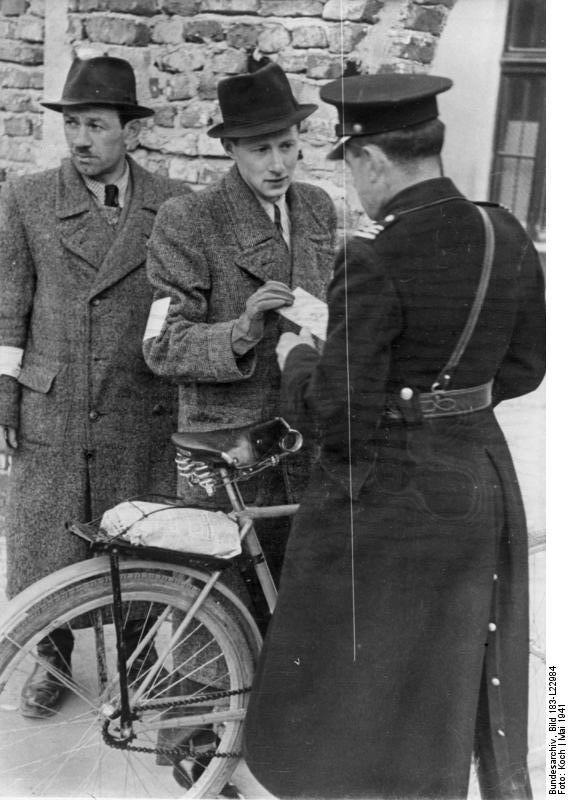
Polish “navy-blue policeman” checking identity cards by the Kraków Ghetto. Photo credit: Wikimedia Commons/ Deutsches Bundesarchiv (Under CC-BY-SA 3.0)
The study’s central conclusion is that “over 60%” of Jews who escaped the ghettos perished, and that the “overwhelming majority” of those cases involved at least some Polish participation. The forms of complicity were diverse: local Poles reported Jews or personally escorted them to the German gendarmerie; Polish “navy-blue policemen” assisted German units in “hunts” for Jews or murdered on their own initiative; local groups and even children flushed out Jews hiding in forested areas; Polish underground resistance units killed desperate fugitives; villagers murdered their long-term neighbors; Polish “gawkers” participated directly in German-led killing during the liquidation of the ghettos.
The study includes painstaking detail on hundreds of cases, each one an unimaginable tragedy of fear and suffering for individual human beings. The scholars use mutually-confirming evidence from various sources, including survivor testimony and records of investigations and trials from post-war Poland and West Germany. The overall weight of the evidence is powerful, with over 5000 documented victims among around 7500 people in hiding in the nine counties. The final analysis is uncompromising: From the research conducted, it emerges unambiguously that in the areas of interest (with the exception of the Bielsk Podlaski and Złoczów counties), the overwhelming majority of Jews trying to save themselves – on the basis of researched and verified cases – died at the hands of Poles or were killed with the complicity of Poles (Volume 1, 38).
I will return to the question of the “overwhelming majority,” as this claim is not very clearly supported. However, first of all, it is important to emphasise that the study constitutes an extremely significant achievement. Since the two volumes cover an impressive 9 of 63 counties in the General Government and Bezirk Białystok administrative units (the two large areas mostly overlapping with the territories of both prewar and post-war Poland), it may be possible to extrapolate from these numbers to make much broader claims. In any case, the scope of the study is wide enough to be meaningful in its own right. The authors themselves suggest the need for further work across the remaining counties. In the meantime, the study presents a large body of evidence that Polish complicity in the Holocaust was more widespread than previously thought.
At the same time, the book introduces plenty of specific detail and nuance as to what “complicity” meant. The authors explain and hypothesise a range of different circumstances and motivations. In many cases, Poles betrayed Jews on direct German orders in an extreme climate of fear and recrimination. In her chapter on Bielsk Podlaski county, Barbara Engelking suggests that unquestioning subordination to authority was a prevalent characteristic of the Polish “village mentality,” inclining people simply to obey the occupiers and thus to report various kinds of illicit activity, not just the concealment of Jews (Volume 1, 165-66). Very often local village authorities oversaw actions to hunt down Jews on German instructions. In some cases, preexisting antisemitic prejudices, local score-settling and inexplicable appetites for cruelty seem to have been additional contributing factors. In other circumstances, simple greed for goods and property was the main motive.
On the other hand, the study also shows that around 30% of Jewish fugitives from the ghettos survived in the nine counties. In the vast majority of cases, survival was only possible with substantial assistance from local Poles, some of whom have later been recognised as “righteous among the nations” by Yad Vashem in Israel. Jews survived mostly by hiding in barns and outbuildings, or, less commonly, in rooms, cellars and attics of houses. Many were forced to move from place to place, often spending periods in forests and fields; others were lucky enough to find a single hiding place until the end of the war.
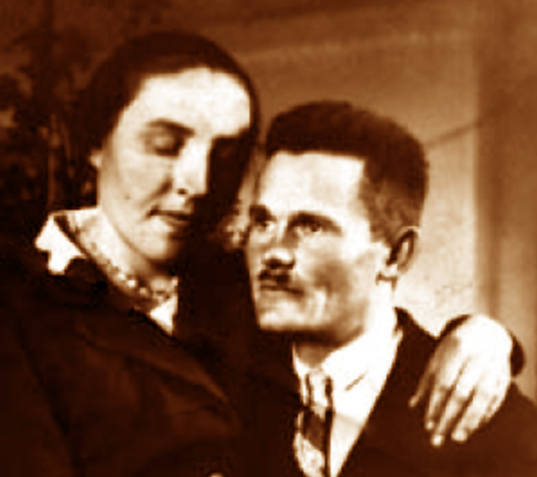
Józef and Wiktoria Ulma
As with the Polish perpetrators, the motives of the Polish “righteous” were various. Some helped from profound commitment to their (usually Christian) personal value systems; some rescued people they already knew and liked; some helped largely or exclusively for financial gain. All were taking significant risks, as the Germans frequently executed helpers and their families (though not in all cases). To both Jews and their saviors, other Polish neighbors represented an ever-present threat, often due to widespread fear of the potential collective consequences of altruism in the deadly climate established by the German occupiers: Those who were willing to help quickly met with the hostility of those around them, who did want to take on a collective risk to save their Jewish neighbors. [. . .] There was no collective agent of rescue. In every situation of aid that I came across, the collective signified danger and death, while those who recognized in the hunted, denounced and murdered Jews people in need of rescue were absolute exceptions (Volume 2, 344, 355).
Much of the evidence suggests that hostility and indifference were widespread among Polish “bystanders” in local communities. Some non-collaborators tacitly consented to the murder of Jews by failing to impose even informal social sanctions on collaborators. Poles who had killed Jews were often not ostracised from their communities. On the other hand, pity, horror and outrage were also common reactions to the unfolding violence. When it comes to the broader apportioning of blame, several key questions remain. What proportion of the murdered fugitives were killed with Polish complicity? What proportion of local Polish populations were engaged, respectively, in the activities of saving and betraying? Finally, in the context of overall German responsibility for the occupied territories and in the absence of a collaborationist Polish state, how can we quantify the general level of moral responsibility that Poles must bear for these actions? As Barbara Engelking observes, there is a desire to arrive at a precise figure to capture the level of “Polish” guilt. Regrettably, some of the early discussions of the new study have muddied the waters in questions that require either precision or a suspension of judgment until sufficient evidence becomes available.
Controversial numbers
The publication of the two-volume study has met with a predictably mixed response in Poland. Liberal and centrist media and intellectual circles have welcomed it as an important contribution to ongoing research and public discussion, sometimes even reacting with a sensationalised emphasis on Polish guilt. A Newsweek Polska front cover pictured a blood stained Star of David with a penetrating knife, along with the accompanying words, “How Poles Finished off the Jews: For every three Jews who escaped from the Germans during the war, two were murdered by Poles.” Some conservatives have responded with outrage, accusing the authors of “trying to convince Poles that they – together with the Germans – are co-perpetrators or perpetrators of the Holocaust.” Members of the government have also reacted negatively. One of the book’s editors, Barbara Engelking, will reportedly not have her position as the Chairwoman of the International Auschwitz Council renewed by Prime Minister Morawiecki. Deputy Prime Minister Jarosław Gowin has publicly described Engelking’s work as “controversial.” The Head of the Institute of National Remembrance has expressed reservations about the book.
Much of this criticism seems motivated by knee jerk public patriotism insisting on Polish historical virtue. At the same time, the study is not without flaws, and some of the more laudatory public discussion around it has also been inflammatory and inaccurate. In particular, claims made in the international media, and even by one of the book’s editors, are not specifically supported by the new research. In a short article on the study, The Times of Israel claimed that “over half a million Jewish Holocaust victims [. . .] died as a result of the actions of non-Jewish Poles.” It is unclear where this figure comes from, but it certainly has nothing to do with the evidence presented in the study. In part, the inflated figure may have been extrapolated from earlier claims made by editor and contributor Jan Grabowski, who estimated in an interview in 2017 that Poles might have been at least partially responsible for around 200,000 Jewish deaths:
One can start by saying that about 35,000 Polish Jews survived the war in Poland (excluding those who fled into the Soviet Union and returned after the war). We also know that close to 10 percent of Jews fled the liquidated ghettos in 1942 and 1943 – which would give you a number of about 250,000 Jews who tried to survive in hiding. Subtract the first number from the second and you will see the scale of the ‘dark’ territory, in which the Poles, for the most part, decided who lived and who died.

Jan Grabowski. Photo credit: Wikimedia Commons/Icewhiz (Under CC BY-SA 4.0)
In a more recent interview given for the launch of the new study, Grabowski stood by these earlier claims. However, the research in the two volumes he has edited does not specifically support them. If the book’s documented research is generalisable – and this would seem to be a safer approach than mere subtraction – then we arrive at a figure of 75,000 survivors, or 30% of the total 250,000 Jews in hiding (more than double Grabowski’s figure of 35,000 survivors). It is also possible that even this extrapolated figure is too low, since survival rates may have been higher in large cities, not covered by the study, where there were more assimilated Jews with connections among non-Jewish Poles. On the other hand, if we assume that “over 60% perished” means, say, 65% (my approximate finding after trawling through the two volumes), then the figure of those who died after initially escaping the ghetto liquidations would be around 160,000.
But is it reasonable to assume that the “overwhelming majority” of these approximately 160,000 victims died with at least some level of Polish culpability? For the nine counties examined, the study shows that this was certainly not the case in all locations. Engelking and Grabowski mention Bielsk Podlaski and Złoczów counties as particular exceptions, but there are also other counties for which the evidence is imprecise. The overall figures for direct and indirect Polish complicity remain unclear, as the separate chapters on the individual counties give different types of information and sometimes no figures at all. The significant presence of non-Polish civilians, especially Ukrainians and Belarusians, in some of the counties covered by the study further complicates the picture.
This lack of consistency on numbers is especially irksome given the editors’ own emphasis on their importance: “The number of those who wanted to save themselves but perished has not only historical but also moral significance” (Volume 1, 28). Above all, there is no clearly presented evidence to demonstrate how the editors calculate that Poles were partially responsible for the “overwhelming majority” of the documented deaths. The book’s introduction includes tables to show the overall number of Jews in hiding, but presents no transparent data on total deaths and their probable causes across the nine counties.
Based on the most conservative estimates, my calculation from the evidence presented across the two volumes of the study is that around 56% of all victims among those Jews in hiding after the ghetto liquidations died with at least some demonstrable complicity from ethnic Poles (Grabowski suggests the number could be anywhere between 60% and 90%). This lower figure is still very substantial, but it does not represent an “overwhelming majority.” If we return to the projected total number of 160,000 victims, then we get a conservative estimate of around 90,000 victims killed with at least some Polish involvement – a figure that is shockingly high, but much lower than Grabowski’s 200,000. On the basis of similar projections, we might calculate that Poles were responsible for saving the majority of approximately 75,000 Jewish survivors.
In all this analysis, a conservative approach seems especially advisable when we consider that such tentative numbers are based on estimation and extrapolation rather than comprehensive evidence. There can be no certainty that the 9 documented counties are representative of the whole 63. In some counties, the presence of Ukrainians and Belarusians affects the figures, though the study largely takes this fact into account when discussing the specific complicity of ethnic Poles (as have I). Much more research is required to reach a more precise quantitative statement of “Polish responsibility.”
Difficult conclusions
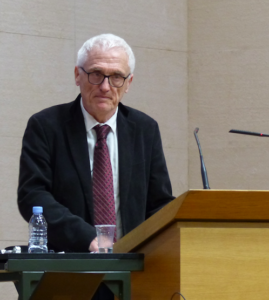
Jan T Gross, author of Neighbors. Photo credit: Wikimedia Commons/Ziel (Under CC BY-SA 4.0)
So what is the point of all this? Am I splitting hairs to get the final number of victims down? Far from it. In overall terms, the real number of Jewish victims who perished with at least some Polish complicity over the entire period of the Second World War may well be higher. Many unexplained deaths are probably attributable to Poles, and there may have been unrecorded killings perpetrated by local Poles opportunistically and without witnesses. Moreover, the new research does not include the pogroms of 1941 (for instance, the Jedwabne massacre described by Jan Tomasz Gross), local Polish participation in murders during and after the liquidation of ghettos (this participation is documented in horrifying detail in the new study), and post-war violence.
If we add all these numbers together, it is even conceivable that Grabowski’s inflated estimate might not be very far from the mark as a final sum of Polish partial guilt. However, there is not currently enough concrete evidence to substantiate this type of general claim. In this context, such an extrapolative leap is surely an irresponsible move for a historian. Moreover, it is a tactical error in a highly charged domestic debate, as such imprecision supplies a ready-made defense to those who are not interested in truth, but simply wish to deny any Polish wrongdoing. It is difficult not to reach the conclusion that the constant aggression from the present Polish government and other conservative circles has shaken the scholarly equanimity of historians like Grabowski and Jan Tomasz Gross, pushing them – perhaps understandably – into imprecise, polemical and even emotive declarations.
In all these estimates, including my own, we also risk missing the crucial broader context. General figures conflate very diverse circumstances. There is an enormous moral distinction between a person who reports a neighbor in abject fear of the occupying regime and a shameless blackmailer or murderer acting for naked personal gain. Yet these diverse cases are all included under the same general understanding of “Polish complicity.” Moreover, the concentration on Polish guilt inevitably pushes the Germans out of the picture. In fact, none of the killing and betrayal could have happened outside the conditions of an occupation for which the Germans bear full responsibility, as Angela Merkel has recently underlined. Even in the most flagrant individual instances of murderous opportunism from local Poles, the German occupying powers still carry a large part of the blame. Inter-war Poland was an increasingly hostile place for Polish Jews, but it was not the scene of mass murder. Moreover, the Polish state did not collaborate with Nazi Germany, but rather went abroad and underground to fight the occupation, sometimes offering aid to Jews.
Especially outside Poland, where historical oversimplification often inflates Polish guilt, these contexts demand repeated emphasis. In the final analysis, my reading of the study leads to the conclusion that almost one-third of Jews in hiding in nine counties of German-occupied Poland were saved with the help of Poles, while at least one-third (and probably more) were killed with the complicity of Poles. These numbers do not tell us what proportion of the Polish population was involved in these activities, and they cannot address the moral and political questions of what it all means for collective responsibility.
How should contemporary Poles process this information? To what extent should the guilt of a minority of individuals acting without the support of the Polish state weigh on collective memory today? Does the emerging research suggest the need for further changes to the dominant narratives of Poland’s traumatic experience under the German occupation? The current Polish government has not created an atmosphere conducive to reflection on these serious questions.
I would argue that in the brutalising circumstances of the occupation, and in the context of prewar Polish antisemitism, it is not the level of collaboration that surprises, but rather the relatively high number of those in hiding who were saved. Poles could do little to stop the transportations to the German death camps. But in situations in which they had genuine opportunities to help, non-Jewish Poles rescued one-third of their Jewish neighbors. In the gathering darkness of a growing understanding of individual Polish complicity with German crimes, this figure shines as a beacon of courageous dissent and decency. We should reflect deeply both on this number and on the weak response of the Western allied powers to the Holocaust before we judge Poles. And then leave it to Poles to judge themselves.
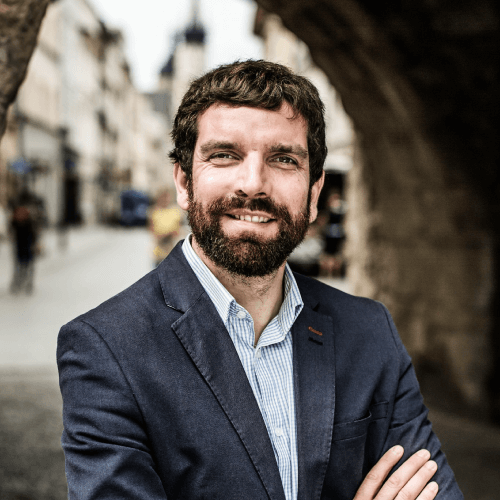
Stanley Bill is the founder and editor-at-large of Notes from Poland. He is also Professor of Polish Studies and Director of the Polish Studies Programme at the University of Cambridge. He has spent more than ten years living in Poland, mostly based in Kraków and Bielsko-Biała.
He is the Chair of the Board of the Notes from Poland Foundation.
